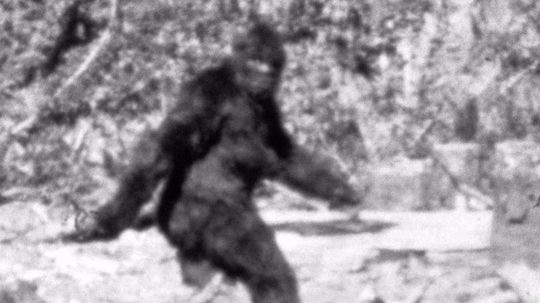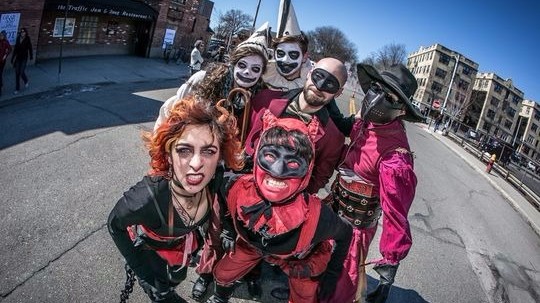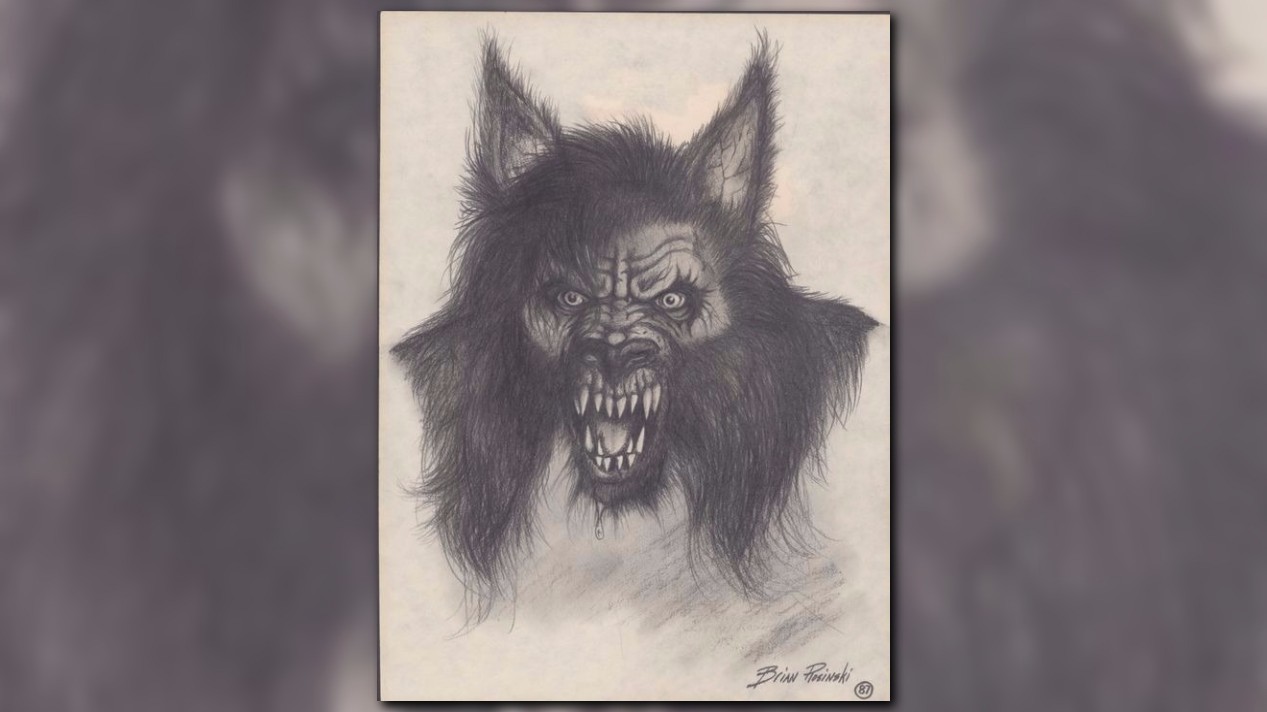Maybe you’ve heard of the Dogman.
For decades, the creature – described as a man with a dog’s head, or a dog that walks curiously upright – has been spotted from Sparta to Bellaire and beyond.
Steve Cook has never seen the beast himself, but helped popularize it with a 1987 April Fool’s Day radio piece called “The Legend.”
“The Dogman song, right from the beginning, was a radio bit, and like most radio bits, we expected it to come and go,” said Cook.
But the spoken-word track became the most-requested song at the station in the following week. It described various encounters over the decades, with a creature that left paw prints frightening a team of horses to death, menacing the crew of a schooner and peering into a van of hippies in the 1960s.
“We started getting all kinds of calls from people who said, ‘That’s no joke. That’s a real legend around here,’” he said. “’I’ve seen it,’ several of them said.”
In the nearly 30 years since, Cook has heard of maybe 100 sightings of the beast. There have been two short films, both starring Michigan native Larry Joe Campbell.
But the Dogman is only one of the mythical creatures some believe are skulking in our forests, swimming in our waters or maybe even hiding in plain sight.
Have you ever heard of the Melon Heads, a pack of angry, tiny people who purportedly live around Saugatuck?
Or Pressie, a serpent named after one of the places it has been seen, in the waters where the Presque Isle River meets Lake Superior?
Michiganders who swear they’re in their right minds say they’ve seen Bigfoot, a humanoid swamp monster in the Huron National Forest, a water monster in a swampy area near Lake Leelanau and a panther roaming the Detroit suburbs.
It all has to leave you wondering, right?
Not Linda Godfrey. The Wisconsin researcher, author of “Weird Michigan” and other books on unexplained phenomena, has made her own visits to the Upper Peninsula in search of Bigfoot. She has heard earnest reports of beasts and creatures that don’t seem to belong in a modern landscape.
“From the sheer number of sightings and the continuity of them over the years, in various places, you can’t put them all off as figments of the imagination,” she said. “They are real in some way to all of these eyewitnesses.”
Although he may be single-handedly responsible for popularizing the Dogman legend, Cook counts himself as a skeptic. Mostly.
“When I’m walking my dog at sunset and a twig snaps behind me, I look over my shoulder with a little bit of a quiver,” he said. “There are new creatures being discovered by science every day.”
Let’s take a look at a few of Michigan’s enduring legends. Have you seen any of them?
Dogman
The beast with a human stride and a dog’s head has been reported many times over the decades. Cook himself knows of nearly 100 reports that have come out since “The Legend” first aired in 1987.
He said some of those who have sighted the Dogman kept the story to themselves for years, fearing ridicule.
“They didn’t want to talk about it because everybody would think they were crazy,” he said. “The song was this catalyst they could latch onto.”
Both Cook and Godfrey refer to Native American lore as a potential explanation for the Dogman legend.
“There was this warlike tribe and they had the ability to transform themselves into any creature they chose when going into battle,” Cook said. “They chose the wolf because he was the scariest and the most awesome.” What the tribe probably did, he says, is cover themselves in wolf pelts when preparing to fight.
Godfrey offers an alternative: the Dogman and other beasts are spirit creatures that come to this world and assume corporal form, then return to the spirit world.
A more earthly explanation is that the Dogman is simply a wolf or wolf hybrid that, for some reason such as a missing forelimb, has learned to move upright.
“Bipedal locomotion is not supernatural,” Godfrey said. “Any mammal can do it if it is trained or motivated.”
Bigfoot
Reports of a huge, hairy humanoid that leaves gigantic footprints behind come in from all over the country, Godfrey said. Although the Pacific Northwest has made a tourism industry out of Bigfoot, Michiganders have stirred themselves into a frenzy over the beast more than a few times.

Take, for instance, 1965. That’s when a mother and daughter driving in a rural area in Monroe County saw a tall, hairy, man-like thing run in front of their vehicle. It punched the 17-year-old and slammed the other woman’s head into the dashboard, then ran off.
“It’s actually one of the most famous Bigfoot incidents because it’s unusual that you would have this degree of physical interaction,” Godfrey said.
An 8-foot-tall hairy beast has been spotted near Oscoda in the Huron National Forest, first seen by hikers, and in the fall, hunters.
“In one case two hunters shot a deer and Bigfoot got there first and dragged it away,” Godfrey said.
Godfrey is acquainted with a deputy sheriff in Wisconsin who owns a vacation cabin in the western U.P. She said he has seen Bigfoot there twice.
“That’s one I personally know of, but there are plenty of other sightings and they’re not all in the U.P.,” she said.
Melon Heads of Saugatuck
The Melon Heads – said to inhabit the forests and trails near the Felt Mansion outside of Saugatuck – are reported to be reclusive, mean, strange-looking little people with large, bulbous heads.
Godfrey said the Melon Heads appear to have fellow misfit societies around the country, with their lore similar to the Haunchies of Wisconsin and other legends in Florida and New Jersey.
“In general the feeling is that for some reason there was a colony of deformed children that escaped into the woods from some kind of institution, and even today people have to watch out for them and their descendants,” she said.
She said the myths may be based on a little bit of actual history, such as an institution closing or as in the Florida case, a wintering spot for circus people.
One legend, explored in a 2013 article in the Grand Haven Tribune, suggests a physician named Dr. Crowe studied hydrocephalus after World War II, creating mutants. The creatures are said to have rebelled and attacked him.
The article also relates a more mundane possibility. The mansion once was used as a Catholic school. Public school kids in the area, who thought the St. Augustine students were arrogant, would call them "big-headed" or "melon heads." After the property left church hands in the 1970s, it was used as a state police post and a correctional facility was built. Presumably the Melon Heads remain.
Lake serpents
If you’re hanging out on the Lake Superior shore near the mouth of the Presque Isle River, keep your eyes peeled. You may see Pressie, the Lake Superior serpent, showing humps above the water’s surface as it moves along.
Most of the sightings of the creature took place between 1894 and 1930, Godfrey said, but a 1977 sighting produced an inconclusive photo.
Of course, the most famous mythical lake-dweller on the planet is the Loch Ness Monster in Scotland. That beast is described as having a long neck and a bulbous body, while Pressie is more snake-like.
Great Lakes Indian lore also describes the mishipeshu, an underwater panther with a stripe along its back and a long tail.
Maybe Pressie gets around – a similar large serpent also has been reported over time in the Straits of Mackinac.
Another water monster hasn’t been sighted since early in the 20th century. The Lake Leelanau monster, which was sighted in weedy shallows, allegedly extended its neck upright in the water. It appeared to be a log until a boater ventured too close to it. Then its eyes opened and the teenage boater fled as fast as he could row.
“I think people should be skeptical and look for mundane explanations first,” Godfrey said. For example? Some folks in Wisconsin were certain they were watching a lake monster crossing a body of water in Wisconsin – until it climbed out of the water and turned out to be a horse covered in lake weeds.
Mysterious panthers
In the Oakland County community of Wixom, people started spotting a huge, dark-colored cat in the 1980s.
According to an account by Ron Schaffner, a newspaper delivery driver saw a black cat bigger than a German shepherd resting near the road early one morning.
The beast was never captured, but they’ve named their annual Halloween festival the “Panther Hunt” in its honor.
Huge black felines with long tails also were spotted in Flint, Manchester and other Michigan communities during the 1980s.
Wildlife authorities theorized that the big cat was an escaped exotic pet, perhaps a black leopard. Efforts to trap the beast failed.
There have been sporadic big-cat sightings around the state since then, including a 2010 report near Webberville.
Godfrey is less likely to consider panther sightings as supernatural.
“There are far more people keeping legal and illegal exotic pets in this country than most people realize, and they do sometimes escape,” she said.
The Nain Rouge
Could a bad-tempered dwarf be responsible for the City of Detroit's woes?
The legend of the Nain Rouge, or Red Dwarf, suggests so.

The nasty Nain Rouge reportedly is a small creature with fur boots and bad teeth. He may have been the first mugger in Detroit, said to have attacked the city's first white settler, Antoine de la Mothe Cadillac, in 1701. He's said to have placed a curse on the Frenchman, who died penniless after returning to his homeland.
The Nain Rouge also reportedly was seen before a bloody 1763 battle between Native Americans and the British, before an 1805 citywide fire and during the War of 1812.
Sightings continued through the 19th and 20th century, and the mean beast is said to have been seen before the 1967 riots.
Since 2010, Detroiters have been staging a parade and celebration in March in the Midtown/Cass Corridor neighborhood known as "Le Marche du Nain Rouge." Its purpose: to ritually exorcise the ill-tempered beast. Its newfound celebrity also includes having a red wine and a local beer named after it.
"At Detroit’s worst moments," reads a history created by the organizers of Le Marche du Nain Rouge. "the Nain has been there, cackling or taunting the city’s residents."


